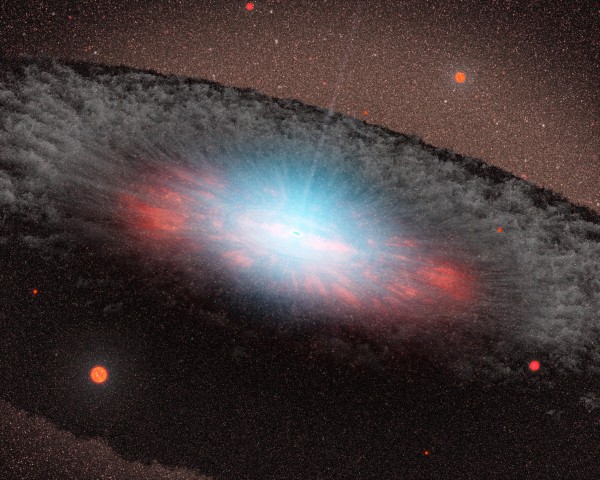Despite What You May Have Heard, Black Holes Haven’t Exactly Been Disproven
Rumors of black holes' deaths have been greatly exaggerated.

New mathematical calculations by Laura Mersini-Houghton, a physics professor and theoretical physicist at University of North Carolina-Chapel Hill, show that black holes may not actually exist! Amazing, right? Well, yes, it is amazing, but that doesn’t make it a fact.
It’s likely that your first reaction to this news is, “Wait, but haven’t we seen black holes before?” You mean those infinitely dense objects that have such high gravity that not even light can escape them? No, that’s made it a little tough to see them.
But I’m joking, of course. You’re right: We’ve found lots of objects out there in the universe that display the effects we’d expect to observe from black holes, even if we can’t see the objects themselves. In fact, gravitational effects on other objects and radiation measurements are really the only way we can observe a black hole until we’re capable of traveling across lightyears to get up close and personal with one.
That doesn’t necessarily make Mersini-Houghton wrong, but the Internet has been overreacting to the news of her calculations a little bit. She says that one little theory will die, and everyone loses their minds!
Until her work stands up to the scrutiny of the rest of the scientific community, we can’t know whether or not black holes are about to go from science to fiction.
Generally, black holes are thought to form when the remnants of a massive dying star collapse in on themselves and compress down to a single point, a “singularity,” which makes them mathematically infinitely dense. This high amount of mass in such a small amount of space distorts the fabric of spacetime so much that it creates a region of space around the singularity whose gravity is so strong that nothing can escape once it crosses the event horizon, or the outer edge of the black hole.
However, as the UNC article on Mersini-Houghton’s work points out, black holes have long caused problems in reconciling Einstein’s theories with quantum mechanics. It states:
The reason black holes are so bizarre is that it pits two fundamental theories of the universe against each other. Einstein’s theory of gravity predicts the formation of black holes but a fundamental law of quantum theory states that no information from the universe can ever disappear. Efforts to combine these two theories lead to mathematical nonsense, and became known as the information loss paradox.
Mersini-Houghton proposes a simple solution to this problem: black holes simply don’t exist. Stephen Hawking used quantum mechanics to show that black holes should emit radiation, and Mersini-Houghton’s math has shown that, as a dying star collapses to form a black hole and emits radiation, this radiation also causes it to lose enough mass that it never becomes dense enough to have the gravity needed to create an event horizon and become a black hole.
So then what are all those observations that scientists have made of the effects they’d expect to find from black holes? If Mersini-Houghton is right, they’re some other incredibly dense object that acts as we’d expect a black hole to act, but they don’t have an event horizon or crush anything down into a single point. So it’s not as though the objects we’ve found that we call black holes are just not there; they’re just something slightly different yet still massive enough to hold entire galaxies, including our own, in orbit.
But there’s a catch: This is not peer-reviewed work that has been accepted by the scientific community. Mersini-Houghton’s calculations are available to view in the online archive arXiv, but it’s a bit premature to start hailing the end of black holes. Earlier this year, a team at Harvard held a press conference to announce that they’d finally found previously theorized evidence of the Big Bang before they let the rest of the scientific community in on it, and the finding has since been torn apart and may have been nothing more than a detection of cosmic dust.
So hopefully we’ve all learned a bit about waiting for verification. If the work turns out to be correct, it means big changes for theories like the Big Bang, which hinges on the universe being born from one of these singularities that apparently doesn’t exist. But that’s a big if. We’re talking about one scientist’s—well, two with the help of Harald Peiffer on her final calculations—largely unverified calculations disproving the existence of something that has so far been observed as expected. It’s definitely groundbreaking and worth keeping an eye on as physicists will no doubt battle this one out, but it’s not scientific fact. Everyone should just chill out on trumpeting the death of black holes for now.
(via Universe Today, image via NASA/JPL-Caltech)
- A black hole was recently found in the smallest galaxy yet
- Scientists figured out how black holes pass gas so quickly
- Can light actually orbit a black hole?
Are you following The Mary Sue on Twitter, Facebook, Tumblr, Pinterest, & Google +?
Have a tip we should know? tips@themarysue.com